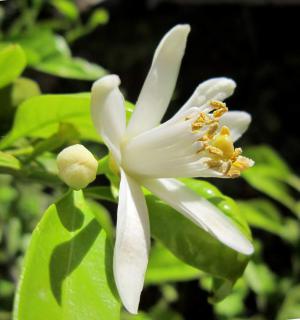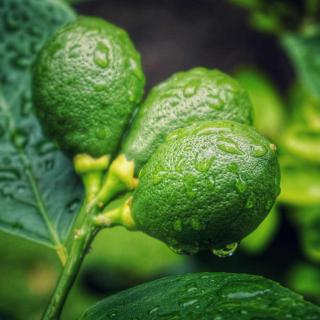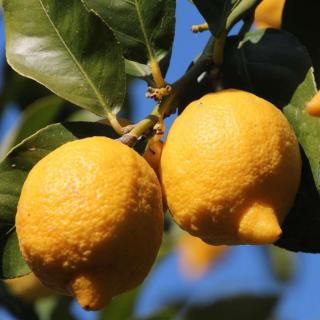

Lemon tree is a rather easy citrus to grow. It looks magnificent, too!
A summary of Lemon tree facts
Name – Citrus limon
Family – Rutaceae (Rue family)
Type – fruit tree
Height – 10 to 16 feet(3 to 5 meters)
Exposure – full sun
Soil – well-drained
Foliage – evergreen – Flowering – Summer – Harvest – winter
Planting, caring and pruning it are steps that help enhance fruit-bearing and avoid diseases on your lemon tree.
The planting of the lemon tree is an important step that influences lemon production.
Planting lemon trees in the ground is possible only in mild-wintered areas. They are vulnerable to freezing and need temperatures that never drop below 41 to 44°F (5 to 7°C) in winter.
Plant your lemon tree preferably in spring, after the last frost spells. Choose a sheltered spot well-endowed with sunlight.
If it freezes in your area, try to grow your lemon tree in pots with shelter for winter.
Lemon trees can’t survive indoors in winter, so they will need an outside unheated greenhouse, or horticultural fleece if the climate stays mild enough.
Pruning isn’t really needed, but if you don’t prune it, your lemon tree will quickly grow very large. Yellow lemon trees are particularly vigorous, and require pruning, especially if grown in pots.
Pruning is best in spring, ideally during the months of March, April or May. You should never prune before or during winter, this would make the plant vulnerable to freezing.
Using a disinfected hand pruner, cut each new shoot back to more or less half its length, taking great care to cut just above a leaf.
Remove dead wood regularly and clear the inside branches to let light penetrate to the center.

In pots, water as soon as the soil is dry, without flooding the pots. It is best to water with collected rain water, because they are vulnerable to calcium ions in water. Tap water often is too hard, leading to chlorosis.

Regularly give them citrus-specific organic fertilizers to give them the best chances of developing well.
Growing them in pots is most adapted, because that makes it possible to bring the lemon trees to a spot where it doesn’t freeze in the winter.
Lemon trees aren’t indoor plants, and can’t bear staying in a heated environment all year round. They need relatively lower temperatures from October to May, especially during the night.
Lemon tree diseases and parasites are the same that would attack most citrus plants.
Rotting fruit, aphids or scale insects don’t spare lemon trees and you’ll find proof of their presence on leaves.

In the garden, too, you can use lemon to repel ants and keep them from climbing up your fruit trees where they tend to aphids. Simply cut the fruit into slices and tie them around a tree trunk. Block all passageways by overlapping the slices a little.
Pick the lemons as soon as they easily break off from their branch.
Credits for images shared to Nature & Garden (all edits by Gaspard Lorthiois):
Lemons on tree by John Englart under © CC BY-SA 2.0
Lemon tree flower by Ulrike Leone under Pixabay license
Unripe lemons by Free Photos under Pixabay license
I just planted a eureka lemon that has large lemons. Should I pick the unripened fruit so my tree has a better chance of taking root in its new home.
Something is eating the leaves on my Meyer lemon tree. How do I treat it?
Hi Diane, what do the holes look like? Is it like bites along the edges of the leaves? If so, you’re dealing with caterpillars. A few swallowtail butterfly species love citrus trees specifically. The best course of action is to pick them manually, but you can also try natural treatments that use bacteria to get rid of them.
If it’s more like spots and strange scales, then it’s probably scale insects. These would require soapy water spray to cut back the infestation, or finding ways to attract beneficial predator bugs like predator thrips, ladybugs or green lacewing to the tree. Sometimes larvae of these beneficial insects are available for sale in garden stores, it’s worth looking around.
Those are the two main animal causes for leaf damage on meyer lemon trees. After that, there are lots possible other problems, like fungus, gall wasps, etc, but they usually don’t look like “something is eating the leaves”.
I have two plants from the same lemon but they look SO different from one another. One is short,beefy looking and the other tall and slender… they both look really healthy though, does this happen often ?
Hi Leone, that’s a really fun proof that the mother tree is only responsible for 50% of the children’s genetics. Because of cross-pollination, the genetics is different from one seed to the next. It seems as though different pollens fertilized the flowers that later became the same fruit. Usually, within an orchard, most trees either self-pollinate or are crossed with a single other species, meaning sibling seedlings are very similar. However, in your case, perhaps the lemon grove had very different neighbors, as in one particular variety to one side and another to the other side. It might even be that another citrus species altogether fertilized the plant, such as an orange or grapefruit citrus! You’ll only be able to guess which once you get fruit, though. Plants like Calamondin, kumquat, bergamot and more are actually hybrids of earlier, older species like citron or finger lime. The citrus family hybridizes very easily.
There’s also a slight chance that growing conditions for each are a bit different, but if you planted and started them with the same potting soil, watering and exposure, there shouldn’t be so much of a difference.
Hi, we have been experimenting with seeds during lockdown and together with my son, planted several different seeds at the beginning of lockdown (about mid-April). One of those was lemon. It’s now about 12inches tall and we’ve got several fruit growing! Is this normal? Should I let them grow? It’s such a tiny tree, I wasn’t expecting it to bear fruit at all. Thank you!
Hi Nathalia, that’s fun! A few months is a bit young for a lemon tree to bear fruit: it would focus too much energy towards growing the fruit. It might weaken itself too much and not survive that very first winter (especially if left outdoors). However, if you’d still like to pursue the experiment with fruits, why not remove all but one fruit? That single fruit should be enough for the lemon to cope with. If the stem is very thin, though, find a way to “carry” the fruit: pile up a few rocks or blocks of wood under it to bear the weight as it grows heavier. Indeed, it might very well break the stem! If you try this, also remember to keep your lemon tree indoors over the winter, or the cold might kill it. If possible, keep the air moist around it, most of all when the heating kicks in since it tends to dry air out a lot.
Hi i was wondering if you remove all the lemons from your tree once they’re ready rather than letting some die on the tree, will it affect the lemon production in the future?
Not really. They’re “ready” when it doesn’t take much effort to pull them off. A light plucking is all that’s needed. If you simply let the lemons hang to the tree, most of them would drop naturally with the slightest gust of wind anyways.
Actually, the only time when the fruit would really stay for a long time and dry up on the tree is not a good sign at all: it means the fruit/branch is infected with a fungus such as fruit rot. This fungus changes the chemistry in the plant to strengthen the stem and keep the fruit from falling. Why would the fungus do that? So it can overwinter high up in the tree and, come Spring, it’s in a great position to spread spores all around as far as can be, much better than if it were stuck on the ground.
So actually, leaving fruits to die on the tree, at best, won’t do anything and, at worst, might help spread diseases that will definitely lower fruit yield.
I have a Lemonade tree that is eighteen months about 1 metre high and is developing fruit in clumps of 3.
My question is should I remove this fruit so as to assist the growth of the tree???
I would appreciate any advise you may be able to offer.
Hi Ian, 18 months is early, but that simply means your young tree is ready to bear! To have grown that large, it’s for sure in a good environment. You needn’t worry about helping your lemon tree manage its resources. At some point, if it feels it needs to slow down, it may naturally drop a few of the fruits. Note that in many cases, some fruits are still ripening when a new batch of flowers blooms, making it a continuous supply!
What you can do is make sure the tree has enough nourishment. Mulch with organic material to provide nutrients to your lemon tree as the mulch breaks down. Recycle weeds into fertilizer to give it a boost from time to time, too.
Hi Gaspard,
Thank you for your response I will most certainly take your advise on board. I didn’t mention the fruit is only 10 cents in size.
I will now increase the area around the tree to the drip line and add compost to improve the growth of the tree.
My question also refers to babies that have been grown from seed. I have orange and lemon trees that are 4months old. There is 3-4 inches of new growth above the inital leaves fom when they sprouted. Those leaves are very small in comparsion to the new growth. The question is should they be removed ?
Hello Sandy, it’s exciting to grow citrus from seed! The initial leaves are actually very special, they’re part of the original seed. They’re called cotyledon, or “seed-leaf”. As long as they’re green, they’re still helping the plant grow. You should only remove them once they wither and dry up, not before. Even the withering is a way for the plant to recover nutrients from the leaf as it “shuts down”.
If you do prefer to remove them, for instance if you’re planning to offer a seedling to someone as a gift and feel it would look better, you can. Usually over 4/5ths of the cotyledon reserves are already consumed within the first two weeks. Since yours are four months old already, there’s not much left for the plant to be deprived of.
It’s normal for these first leaves to look very different from the seedling’s own, new leaves.
Well I do understand what is said here
but my problem is that you find how to take care of a grown lemon tree but nothing on how to take care of a fresh plant. I’ve grow a lemon tree from seeds and my plants are 2 months old and now I wonder when I need to prune for the first time to split the top into branches
Hi Kurt! Best is to decide how tall you’ll want your plant to be, and whether you hope for it to have a “normal” shape with one trunk and side branches, or an “orchard” like touch, which branches out more regularly and typically grows wider. In small quarters, the “normal” shape is better because it can grow taller and not so wide.
Once the main trunk has reached the height you hope for it to have, mark it with a small ribbon of yarn. Wait until new growth has started appearing beyond that point and snip the bud off with a slant, just above a leaf (about a quarter-inch or .5 cm). This will trigger the growth of side branches. The new side branches will randomly pop out from wherever leaves join the trunk, with a slight preference for the topmost leaves.
After that, simply prune once a year. Sometimes it helps to sketch out the shape you want to give your tree so that you can come back to it and remember what you were aiming for. Remember that pruning on old wood isn’t as comfortable for the plant, so it really helps to prune yearly and remove from the new growth what you don’t want to leave behind.